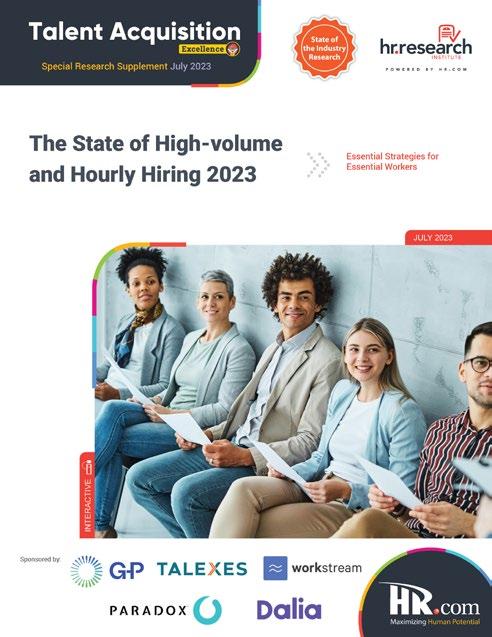
7 minute read
THE GIG IS UP: A RECRUITER’S GUIDE TO RISK REDUCTION

- Joy Henry, Head of Sterling’s Technology and Business Services group
Advertisement
On the Cover
Articles
10 What Hourly Job Seekers Want From High-Volume Hiring

Enhancing candidate experience and attracting top talent
- Matt Parkin, Business Development Lead, FindWRK
15 How To Lose A Candidate In 10 Days
Foolproof ways for employers to avoid getting dumped by the class of 2023
- Christy Spilka, Vice President, Global Head of Talent Acquisition, iCIMS
The Gig Is Up: A Recruiter’s Guide To Risk Reduction
Overcoming the challenges of hiring and onboarding gig workers and contingent employees
- Joy Henry, Head of Sterling’s Technology and Business Services group
49 The ‘Zero Visibility’ Problem In Global Recruitment
Gaining visibility into global HR and talent acquisition
- Lenna Thompson, Head of Client Services, RAMP.Global
The State of High-volume and Hourly Hiring 2023
Essential Strategies for Essential Workers

High-Volume Hiring Is Here To Stay. Here’s How You Can Do It Better
Learn how successful teams achieve their high-volume hiring goals and how you can reach yours too
- Doug Leonard, Co-Founder and CEO, Clovers
Improving Candidate Experience In High-Volume Hiring
7 essential steps for success
- Brett Farmiloe, Founder and CEO, Terkel.io
End Game: 5 Talent Acquisition Trends That Prove The Apocalypse Is Nigh
Learn how recruitment tech has fallen on its SaaS, leading to diminishing returns and increasing commoditization
- Jim Durbin, Managing Principal, Respondable
Top Picks 12 18 54 61
Grow Fast But Smart: How To Hire For A High-Growth Organization

Effective strategies to thrive in high-growth mode while hiring top talent

- Hari Kolam, Co-Founder and CEO, Findem
Editorial Purpose
Our mission is to promote personal and professional development based on constructive values, sound ethics, and timeless principles.
Excellence Publications
Debbie McGrath CEO, HR.com - Publisher
Dawn Jeffers VP, Sales
Sue Kelley Director (Product, Marketing, and Research)
Babitha Balakrishnan and Deepa Damodaran Excellence Publications Managers and Editors
Talent Acquisition Excellence Team
Matt Charney Editor-in-Chief
Deepa Damodaran Editor
Nataraj Ramesh Design and Layout (Digital Magazine)
Vibha Kini Magazine (Online Version)
Submissions & Correspondence
Please send any correspondence, articles, letters to the editor, and requests to reprint, republish, or excerpt articles to ePubEditors@hr.com
For customer service, or information on products and services, call 1-877-472-6648
Matt Charney Editor-in-Chief, Talent Acquisition Excellence
High Volume and Hourly Hiring in the Post-Pandemic World
Forall the work-related changes wrought overnight at the onset of the Pandemic, beginning on that fateful day when we left our offices (mostly) for the last time, winding up our final Zoom free meetings and chocking back a coda of crappy communal coffee (ugh), one still stands out as perhaps the most underrated- and maybe, the most profound.
Virtual work was always a thing, at least at companies enlightened enough to understand that lower capital costs, a global talent pool and (at the time) a hell of a competitive culture differentiator.
Similarly, Zoom instantly became a verb, but maybe only because magically, the need to Xerox anything ended more or less overnight, and also, because the virtual meeting market was already so entrenched even Microsoft had time to roll out a copycat catch-up play.
The most profound change instead came from us finally defining that thing that we all thought about but never really said. But somehow, in the middle of the discourse about the new virtual working order was this recurring theme of “essential” and “non essential” workers. And for the first time, many of us were forced to realize that the knowledge economy is essentially non-essential (ergo, this post).
That the executive and professional positions we sourced and recruited for in the fierce competition for the finite pool of talent, no quotation marks needed, were not actually a business imperative but instead, someone dispensable to how business gets done, even when it’s anything but.
Essential workers, unlike, say, management consultants or content marketers, are the overwhelming majority of active workforce participants (before and after COVID), and are the foundation upon which the bottom line and the global economy are built. Without essential workers, fires would go unchecked, crimes unsolved, and patients untreated.
Goods couldn’t move from warehouses to big rigs to your front door without them, nor could you go to a store instead. You could no longer buy groceries or go out to eat.
The list of essentials that essential workers provide us is essentially infinite, which is why, while we were trying sourdough starters, ordering DoorDash and reveling in an unending yet mandatory period of working exclusively in sweats, those essential workers were, you know, essentially working. Non-essential workers? Like we ever had a real job other than occupying our little niche of late-stage capitalism.
Non-essential workers, of course, bristled at the suggestion that the delivery guy, the bus driver, or the gas station attendant were somehow more important, more essential, to the continuity of the economy than they were.
Early career professionals, inculcated with the idea that they were somehow a coveted and irreplaceable human capital commodity, were shocked when the realization finally hit that no one really needs a social media marketing coordinator or a talent sourcer when the end is nigh. They will, however, need mechanics, waiters and fulfillment specialists, at least until the moment of Rapture.
The fact is that workers have always been bifurcated into the essential and non essential, between those that do and those who “manage” or “consult” or “recruit” or whatever their title infers they really do, which is often really little.
And in TA, we have long had a bias against essential workers, who we see as disposable and interchangeable cogs, and those random, high-paying roles that require a lot of high-touch hiring and even more process complexity.
The roles that we spend the most time and resources on, as a rule, are the most non-essential - and the most critical of headcount (and a majority of hires) are often seen as more process issues than real people imperatives. Anyone can recruit for positions whose only requirements are a pulse and the ability to lift 50 pounds, was (and is) seen as somehow less than, even though it’s never enough.
This divide, of course, is best understood by the more entrenched lexicon; essential workers are most commonly categorized as “hourly” or “high volume,” and hiring those workers remains relatively esoteric and marginal in the world of corporate TA, despite the lessons learned during the downturn.
Of course, some changes persist - namely, that after millions of hourly workers lost their jobs in the first few months of the pandemic while the majority of white-collar workers enjoyed government-subsidized job and income protections, in addition to the thrill of working in slippers, a profound reversal has taken place.

As almost any recruiter can tell you, the hiring landscape for the types of reqs that keep internal TA teams employed continue to lag in terms of recovery; layoffs of teams with thousands of highly paid, and once highly recruited workers dominate headlines, often directly above the more boring ones about historically low unemployment and unprecedented numbers of open jobs that remain infilled in their millions.
That’s because, as mixed as the TA outlook may be, the truth is that for high volume and hourly hiring, the demand has never been greater - and meeting that demand has never been more, well, essential.
That’s why I’m so excited about this month’s issue of Talent Acquisition Excellence. It’s all about the current state, and future direction, of high volume and hourly hiring - from unveiling the findings of our latest annual HR.com high volume state of the industry report to insights and analysis from some of the experts and leaders influencing how high volume hiring happens today - and shaping what the future of high volume recruitment looks like tomorrow, too.
The answer is, in short, that the future of recruiting and the future of high volume are the same. Because TA goes where the jobs are - and for the foreseeable future, those jobs, and ours, are on the front lines, not in the back office. Which is why this issue - both the magazine and the high concept - is so important.
You could even say they’re “essential.”
Happy hunting.
How are our Talent Acquisition Products and Services helping to make you smarter?


Talent Acquisition Excellence - Monthly Interactive Learning Journal
This monthly interactive learning experience captures key metrics, actionable items and keeps you focused on developing yourself and corporation as top leaders in the Talent Acquisition space.
Talent Acquisition Virtual Events

Talent Acquisition Virtual Events offer webcasts and demos on topics in any of the staffing related programs: Contract Workforce and Talent Exchanges, Online Staffing and Sourcing, Recruitment Process Outsourcing, or Quality of Hire. Learn how to bring the right staffing and recruiting programs into your organization and make them impactful. Listen to the world’s top thought leaders in the staffing industry as they help companies make decisions in all areas of staffing and recruiting. Each Virtual Event consists of up to 10 credit webcasts.
Talent Acquisition Webcasts for Credit
HR.com webcasts deliver the latest Talent Acquisition industry news, research trends, best practices and case studies directly to your desktop. Webcasts are available live online with a downloadable podcast and a copy of the slides (PDF) available before and after each webcast. Earn all of the required recertification credits for aPHR, PHR, SPHR, GPHR, and SHRM Certifications. HR.com’s one-hour webcasts, in every HR specialty including Talent Acquisition, are pre-approved for HRCI and SHRM credit (excluding Demo webcasts).
Talent Acquisition Community
Join almost 55,000 HR.com members with a similar interest and focus on staffing and recruiting topics with one of the four staffing related online communities: Contract Workforce and Talent Exchanges, Online Staffing and Sourcing, Recruitment Process Outsourcing, or Quality of Hire. Share content and download research reports, blogs, and articles, network, and “follow” peers and have them “follow” you in a social network platform to communicate regularly and stay on top of the latest updates. This well established Community is an invaluable resource for any HR professional or manager.










